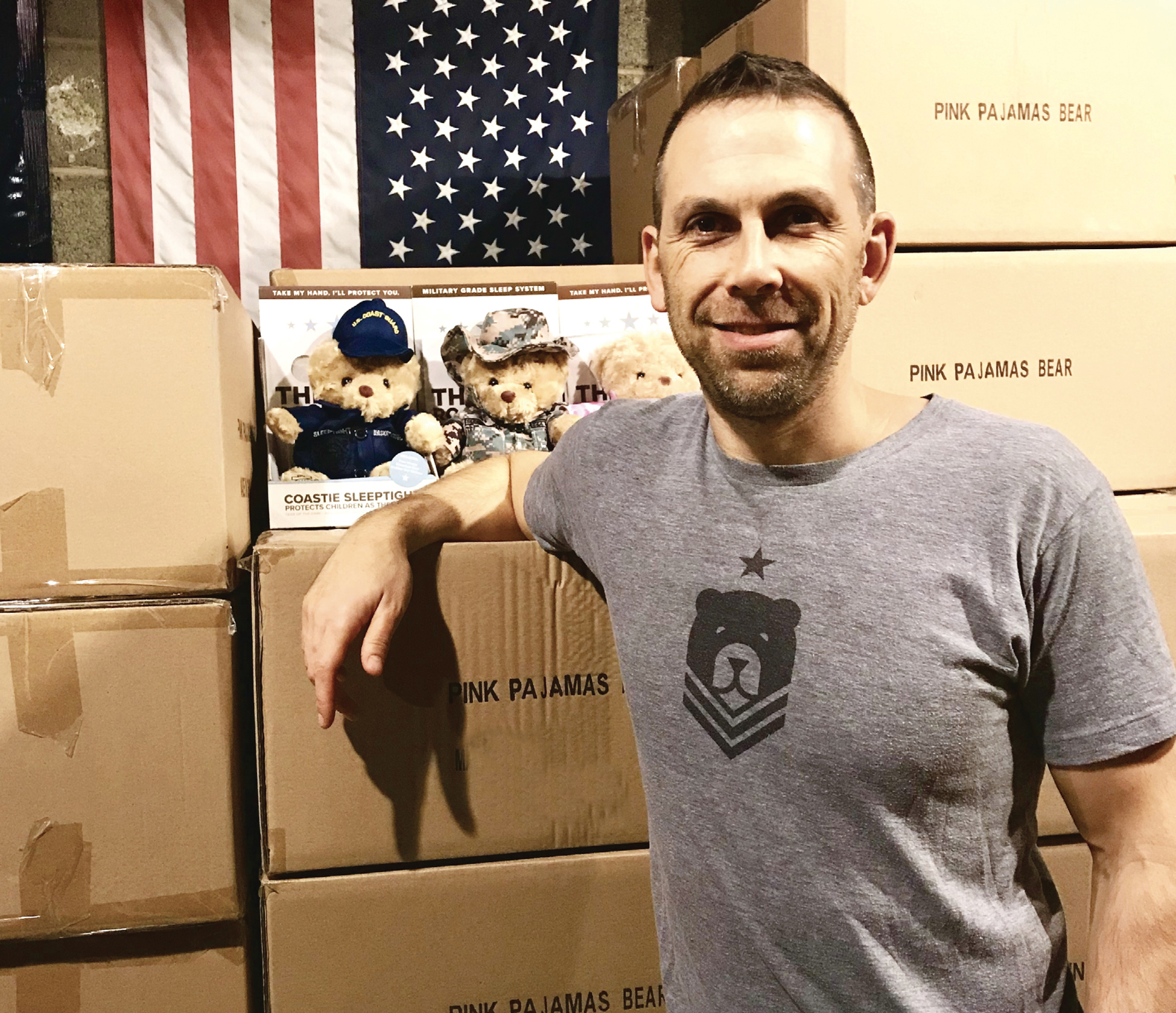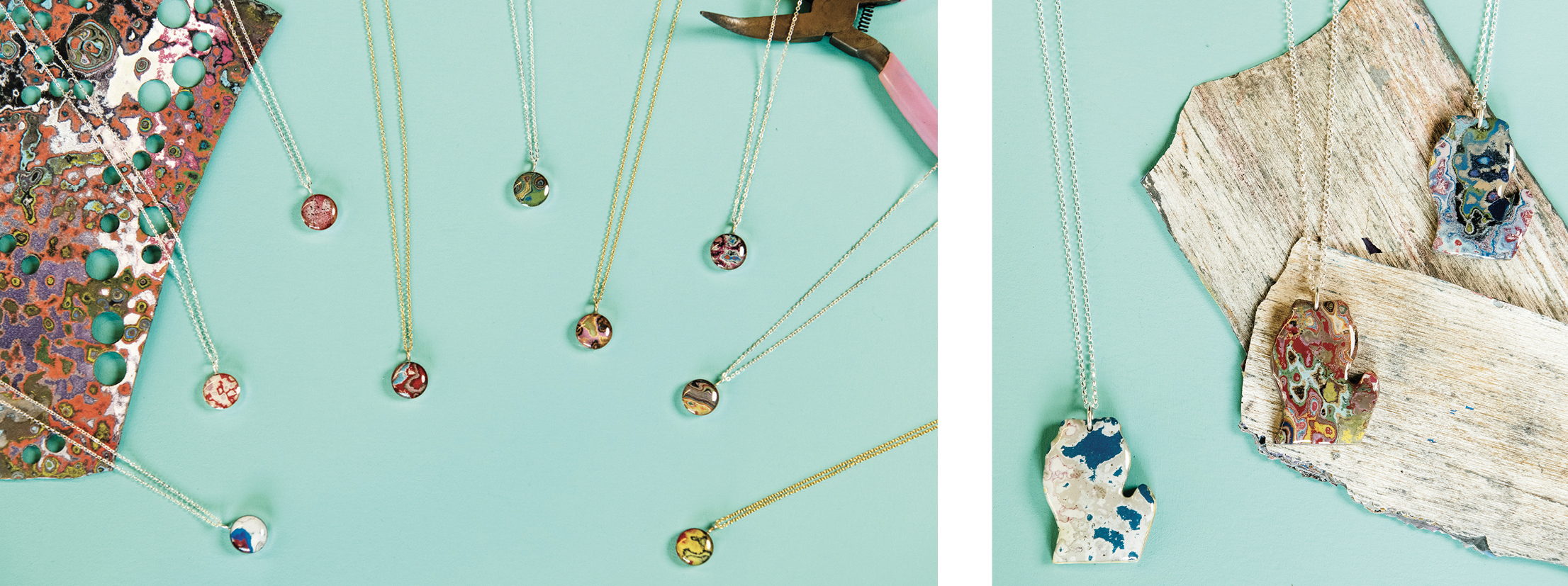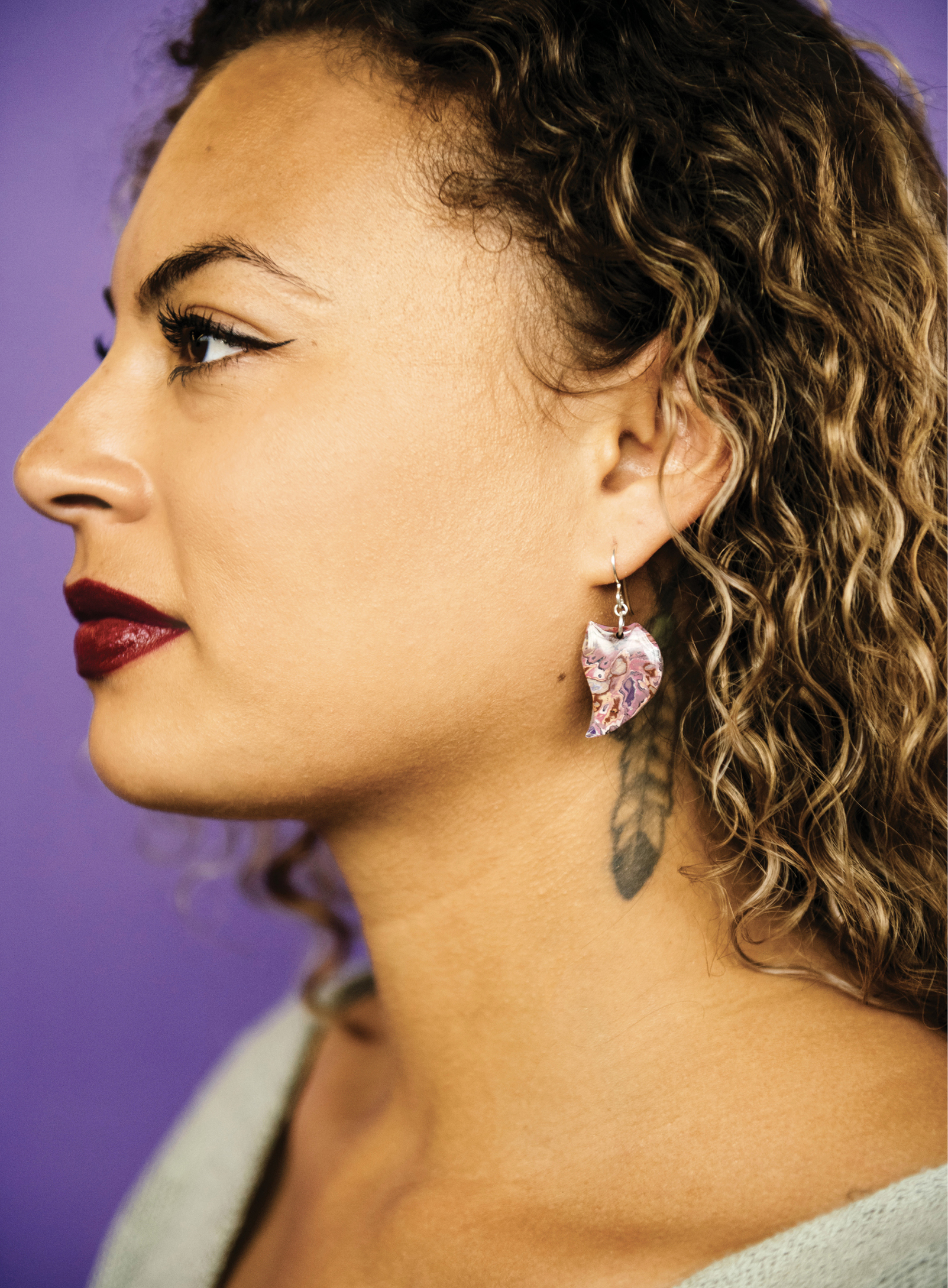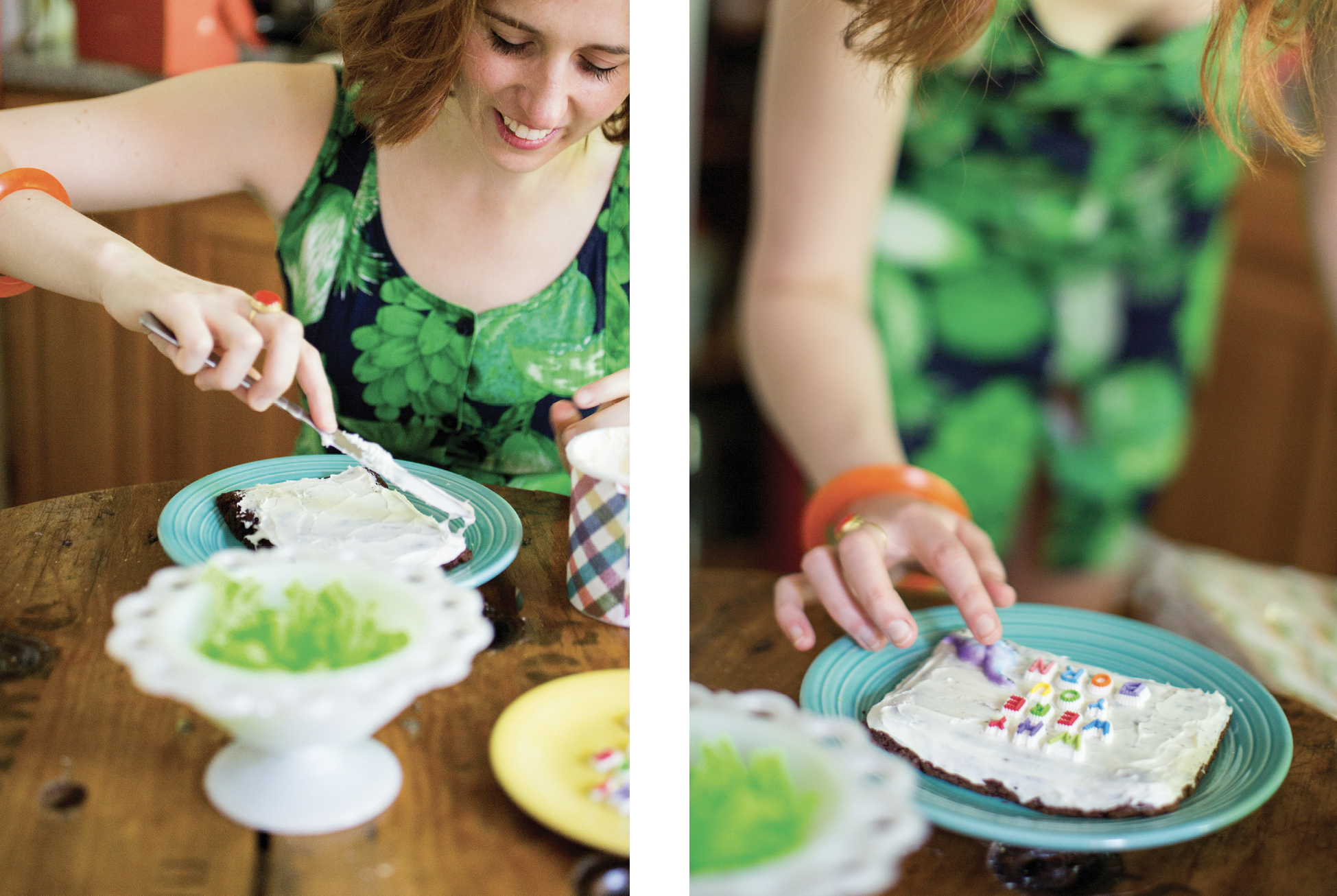
Do Good and Do Well
Don’t choose between profit and philanthropy—do both. You can do good while doing well.
Teddy Bear Military Recruits Help Kids Hibernate
Detroit Women Make Jewelry for Profit and Social Good
Teacher Helps Immigrants Gain Citizenship with YouTube Tutorials
Internet Trolls Eat Their Words in Comedic Cake Campaign
Architect Changes Commuting, One Pocket-Size Book at a Time
Finance Professionals Go Gorillas for Bamboo Fiber Socks
TEDDY BEAR MILITARY RECRUITS HELP KIDS HIBERNATE
NAME
LOCATION
WINSTON-SALEM, NORTH CAROLINA
STARTUP COSTS
$7,500
INCOME
$100,000 IN SALES ($15,000 PROFIT) IN YEAR TWO
WEBSITE
An in-house ad executive turned teddy bear manufacturer creates a military-grade sleep system for children, earning $100,000 in sales and making a lot of people beary happy.
Before taking the job as creative director for the in-house advertising agency at Lenovo, Justin Baum was the lead writer of recruitment advertising for the United States Marine Corps. It was while working there that he was stirred by the men and women serving in uniform. He wanted to find a way to give back. Inspired by his own daughter’s difficulty sleeping through the night, he had an idea.
Justin decided to bring home a teddy bear in a marine sweatshirt. He then told his daughter a story, introducing him as a marine bear who had protected the nation for more than two hundred years. “Now, he’s ready to protect you while you sleep,” he told her.
“Well, what if he falls asleep?” his daughter asked.
“He’s a marine,” Justin reassured her. “He would never fail at his mission!”
That night, she slept like a bear in hibernation. And if this worked for his daughter, he thought, perhaps it could work for other children.
He developed the idea of “Sgt. Sleeptight,” a full-fledged military-grade sleep system that protects children from bad dreams, fear of the dark, and the nighttime anxieties that come from having a deployed parent.
This isn’t your run-of-the-mill teddy bear. Sgt. Sleeptight comes equipped with a door hanger warning nighttime monsters that he’s on guard, a Sleeptight Oath to be read with your child before bed (which officially puts your bear on duty), and Silver Slumber Stars to be awarded after sleeping through the night.
He called his creation ZZZ Bears.
Justin’s talents in copywriting did not lend themselves to direct knowledge of the teddy bear manufacturing world. So, he did what most of us do when we want to figure something out—he Googled it.
His searches led him to Alibaba, the gateway to manufacturing in the East. From there, he typed in “teddy bears,” and the search results returned hundreds of manufacturers. Then, he narrowed his search to ones with experience making military uniforms. Finally, he found one willing to do a small run of two hundred bears.
Prototyping turned out to be easier than expected. Justin sent his manufacturer pictures of different styles of bears he liked. He’d snap a pic of a snout from one, a patch of fur from another, and on and on until he was satisfied with the final design.*
The bigger problem came when he sourced his first order.
His manufacturer came through in the sense that he didn’t run off with the money. However, the quality was subpar…not terrible, but not great. These bears deserved greatness!
In order to scale his business, Justin needed a better manufacturer. He used the power of Facebook, connecting with another plush product designer who had just gotten his product into Walmart. They formed a friendship, and his new mentor referred him to his new manufacturer.
Justin then wrangled a graphic designer friend to design the logo and accessories (door hanger, Sleeptight Oath, and stickers). He built a simple and inexpensive website through Squarespace. And just like that, he had himself a fully functional e-commerce business. He was up and running…now he just had to sell those bears.
On a whim, Justin sent a message to the toy buyer for the Marine Corps Exchange, the directory of stores that sell to military members and their families. The buyer was impressed, and a week later she made an offer to stock them in the exchange. There was just one problem: she wanted the bears to be in a marine uniform, packaged in a retail box. In other words, she liked the concept, but not that first batch he had produced.
Despite the setback, Justin pulled it off. A year later, he got into the Navy and Coast Guard exchanges. Naturally, each one wanted bears in their respective branch’s uniforms. The name Sgt. Sleeptight didn’t work for them because neither the Navy nor the Coast Guard has sergeants. So, in addition to the new bears, Justin had to trademark new names as well. He dubbed his new creations Sailor Sleeptight and Coastie Sleeptight.
For a while, all was well. Justin’s honey jar was full, and the bears were standing sentry in bedrooms across the nation. He was ready for the next step, and when he had the chance to meet with buyers from Target, he thought he’d found it.
After a single twenty-minute meeting with those buyers in a Miami hotel room, Justin had won them over. They loved the bears, or at least he thought they did. They agreed to stock them in five hundred of their stores, or at least he thought they did.
It turned out that getting his bears into Target wasn’t all it was cracked up to be. Setting himself up as a vendor was highly complex, requiring lots of late-night Skype calls with his manufacturer in China. It felt, you could say, more than a little teddy-ous.
On the day his bears were supposed to arrive on the shelves, Justin called his local store to make sure they were available—and they weren’t. Making matters worse, the store manager who took the call had no idea what Justin was talking about.
He then called another store and had a similar conversation. Then, in an act of tenacity, Justin hired three students from his local college to call all five hundred Target locations to see if the bears were displayed.
Turns out, a good number of stores hadn’t even heard of them. Some stores had them in stock, but hadn’t put them on display where anyone would see them. One store even discounted them on their first day.
As weeks went on, Justin kept checking sales numbers. Much to his disappointment, they continued to be poor. He realized that standing out in a big box store in the presence of other popular brands like Disney and Marvel was no small challenge. In a forest full of products, his brand of six bears remained off-duty—and he didn’t have the marketing dollars to make a meaningful advance through enemy lines.
He decided to grin and bear it, changing focus to pay more attention to smaller boutique stores. As Justin described it, “Boutiques are smaller and warmer. There are people there who can explain and sell your product to customers.”
However, being on the shelves of Target did bring him some other opportunities. ABC’s The View ended up doing a feature on ZZZ Bears, and Justin is convinced that his ability to get his product stocked in such a major national outlet gave the network confidence.
They were also interested in his mission to give back. Justin donates bears to children who have lost a parent in the line of duty through a partnership with TAPS, an organization for those grieving the loss of a family member who served in the military.
These days, Justin still relies on asking his audience for help. When he posts a question regarding a product he’s developing, he typically gets hundreds of replies.
“This kind of research used to cost thousands of dollars, now it’s practically free,” he said. Plus, the interaction builds relationships, and his audience feels more invested in the success of ZZZ Bears.
On an annual basis, the project recently brought in just over $100,000 in sales with $15,000 in profit. Clearly, the lack of manufacturing knowledge was no bear-ier to entry in this market.
“Growing up, my mom used to tell me how good I was at everything—from drawing and baseball to brushing my teeth. I now realize it was a well-meaning lie. Nobody is good at everything. Be brutally honest in assessing your strengths and weaknesses, then get help. Find the people you need, put them to work, and stay focused on what you do best. P.S. I love you, Mom.” —Justin
FUN FACT Justin once received a twenty-foot container from China at his front door and had to unload four thousand bears and carry them down his driveway into his house. The laundry room became the assembly room and his garage became the warehouse.
 CRITICAL FACTOR
CRITICAL FACTOR
Sgt. Sleeptight is a hard-working bear, awakening from his own hibernation to keep watch over kids as they sleep. Justin also gives back, donating bears to children who have lost a parent serving in the military.


DETROIT WOMEN MAKE JEWELRY FOR PROFIT AND SOCIAL GOOD
NAME
LOCATION
DETROIT, MICHIGAN
STARTUP COSTS
$15,000 (PLUS A CROWD-FUNDING CAMPAIGN OF $25,000)
INCOME
$300,000 IN YEAR FOUR
WEBSITE
An attorney starts a jewelry company with a purpose, employing disadvantaged women in Detroit to help them transition from a life of dependence into one of self-reliance.
Originally from upstate New York, Amy Peterson relocated to Detroit after earning her law degree. She moved for a job as a sports attorney with the Detroit Tigers. Baseball was a big deal during her childhood, and she had always wanted to work in the sports industry. Every day is different, and she has no idea what will cross her desk.
Growing up, Amy’s family was working-class. When she moved for the job, she chose to live in downtown Detroit, not the suburbs. She wanted to immerse herself in the city, with all its ups and downs.
The juxtapositions she encountered could be jarring. At the ballpark office, she worked on contracts with players who were paid $5 to $10 million a year. Meanwhile, just steps from her front door, she passed by a homeless shelter whenever she went for a run or walked her dog.
The contrast was unmistakable. Amy often stopped to talk with the women staying at the shelter, and she was inspired by their stories. For most of them, getting out of poverty wasn’t a question of motivation—it was a question of opportunity.
As she continued on her run one day, she went past an old part of town near an old railway line. She noticed layers of graffiti coming off the walls. Back in college, she had paid for her education by making jewelry—and that day, she had a big idea.
Her idea was to combine each of these elements: to make jewelry from fallen graffiti, in a way that employed women from the shelter and taught them new skills.
Amy didn’t want to go it alone, so she found a partner. Together, they chose the name Rebel Nell, a reference to Eleanor Roosevelt, and set up an Indiegogo campaign to raise funds. The campaign brought in $25,000, which helped them buy supplies and find a space.
Rebel Nell is a jewelry company with a purpose, one that employs disadvantaged women to help them transition from a life of dependence into one of self-reliance and empowerment. Everyone who works in the business is, or was once, transitioning from a women’s shelter in Detroit.
Amy and her business partner, Diana Russell, teach the women how to make jewelry from that graffiti as a way to repurpose the city. The profits earned directly impact programs and services that help the community of women to lead self-sufficient lives. At Rebel Nell, they operate under a “teach a woman to fish” mentality.
Amy continues to work her day job as an attorney, even as Rebel Nell employs more than fifteen women at a time. And that’s not all. Over the next five years, Amy hopes that Rebel Nell will continue its pattern of rapid growth (the business did $300,000 in sales in a recent year), while at the same time helping women who are ready for the next step in their professional path.
In fact, one of the women who worked for them recently launched her own business. Knowing that Rebel Nell provided her the tools she needed is both rewarding and motivational.
“A majority of the money I make from Rebel Nell goes right back into the company. My reward is seeing the lives of the women we hire improve.” —Amy
FUN FACT According to Rebel Nell, Eleanor Roosevelt was “a strong, independent woman who stayed true to her beliefs, regardless of her husband’s or public opinion.” Amy and her business partner chose to name their new project after her.
 CRITICAL FACTOR
CRITICAL FACTOR
Rebel Nell blends art, commerce, and a philanthropic mission all in one. Whoever thinks you can’t do all three should take a close look at their model.


TEACHER HELPS IMMIGRANTS GAIN CITIZENSHIP WITH YOUTUBE TUTORIALS
NAME
LOCATION
WASHINGTON, DC
STARTUP COSTS
MINIMAL
INCOME
$2,000/MONTH
WEBSITE
A stay-at-home mom and former teacher helps immigrants prepare for the US citizenship test through a series of YouTube tutorials.
When she decided to start volunteering as a leader for a literacy course, Danielle Fang was a stay-at-home mom with two kids. She had previously taught elementary school, but she also enjoyed working with adults, so the volunteer opportunity was a perfect fit.
During the course, she met a woman who was in the process of getting her US citizenship. Danielle did everything in her power to assist—researching the system, accompanying her to the interview, and even observing the swearing-in ceremony. Surrounded by the enthusiastic, soon-to-be citizens echoing the Oath of Allegiance, Danielle was deeply moved.
Soon after, she started volunteering through teaching civics, citizenship, and ESOL (English for Speakers of Other Languages) classes to help others through the same process. One of her first students was a Tibetan refugee who had escaped by walking through the Himalayan mountains to India before finally making it to the United States.
Listening to the student’s story—and meeting others from around the world with similar tales—further inspired Danielle. She wanted to do more to help.
Danielle lives in the Washington, DC, metro area, which has a large immigrant and refugee population. She saw a great need in her community for the kind of support her classes were providing—but the courses usually ran for nine to twelve weeks, and each class was up to three hours long. Furthermore, many of the students didn’t have time to make the full commitment. They often missed classes when they couldn’t get off work or find child care, putting them at a disadvantage through no fault of their own.
Danielle came up with a simple solution. She decided to post all the information and lessons on YouTube so that the students could catch up on their own time. And with that action, she also ended up starting an accidental side hustle.
The goal was to simplify the overwhelming process of US naturalization. Government websites can be confusing for the majority of people, even if you’re a native English speaker. Danielle’s new website and YouTube channel would guide students on everything from how to prepare for a citizenship interview to navigating the cumbersome application process.
Though she originally had no intention of making money off the videos, her husband quickly noticed the traffic the site was generating. At around one thousand visitors per day with an upward trend of two thousand each week, they decided to try monetizing the channel through YouTube’s advertiser program.
They also increased the number of videos she posted each week, using the information she already taught in her classes, as well as information from government websites and experts. In less than a year, she was making a steady profit from visitors who clicked on the ads in the videos.
Startup costs were almost nonexistent. Danielle’s website cost $12 a month. She purchased software for creating the video tutorials for less than $150.
Monetizing the YouTube channel itself was completely free. She made a Google AdSense account, connected it to her channel, and—voilà—at the end of each day, she could log in and see how much money she made.
The channel now generates around $2,000 each month with a nearly 100 percent profit margin. Best of all, this gain doesn’t come at the expense of her students. All of them can watch each video for free, gaining a valuable education without cost, while Danielle gets paid through the partner program. It’s a true win-win!
From her couch at home, Danielle invests about six hours a week when launching a new video, and about two hours a week to respond to questions from subscribers. There are now a few competitors, but she’s been able to stay ahead of the game by providing the most up-to-date information about fees, regulations, and processes.
Even though her kids are now older, Danielle hasn’t wanted to go back to full-time employment and give up on her community work. She says her side hustle has given her the freedom to volunteer even more, without feeling guilty that she’s not earning an income for the household. She now has the best of both worlds.
The business has enabled her and her husband to make some large purchases, as well as start savings accounts for their daughters. It’s also allowed Danielle to help the immigrant community financially, by purchasing books for her students as well as household items and clothing for arriving refugee families.
In the process, she’s become a crusader for side businesses. She loves sharing her experience, and is hard at work convincing her friends that earning a second income for yourself—while giving back—is entirely within reach.
“I love that I am able to continue helping others and volunteer in the community without feeling guilty that I am not earning a salary for the household. Now I do both!” —Danielle
FUN FACT Danielle’s YouTube channel now has twenty-five thousand subscribers and over nine million views. Every day, her videos are watched at least twelve thousand times.
ACTION PLAN
1. Identify a topic that a lot of people are interested in. It helps to choose one that can be confusing or overwhelming—your goal is to simplify the information.
2. Outline a series of lessons. Make them long enough to be substantial, but short enough that viewers won’t give up.
3. You don’t need expensive equipment. Record the lessons using your computer’s webcam and a $50 microphone.
4. Create a YouTube account and upload the first batch of lessons.
5. If your channel proves popular, outline and upload more lessons!
 CRITICAL FACTOR
CRITICAL FACTOR
A difficult test meets a modern technology, and Danielle finds a way to get paid while providing a free service.

INTERNET TROLLS EAT THEIR WORDS IN COMEDIC CAKE CAMPAIGN
NAME
LOCATION
NEW YORK, NEW YORK
STARTUP COSTS
$230
INCOME
AT LEAST $1,000/MONTH
WEBSITE
After seeing a mean comment on Facebook, a woman realizes the absurdity of internet trolling and bakes up a hilarious side hustle.
One day in early 2017, Kat Thek was taking a mental break from her full-time copywriting work. She noticed something on Facebook that struck her as completely absurd. Someone had left a comment on Dolly Parton’s fan page that said, “Your Mamma be so disappointed in you.”
Kat looked at it for a good, long moment. For some reason, the comment just stuck out like a sore thumb. Why would anyone waste their time to insult a complete stranger like that?
It wasn’t even a good insult. It was ridiculous, and also grammatically incorrect. Kat thought it was a strange impulse to want to attack someone with random, senseless Facebook trolling—especially so if it’s someone like Dolly Parton.
A couple of days went by, but she couldn’t stop thinking about it. At some point, the idea of a cake with the troll comment written on it popped into her head—something different than the usual “Happy Birthday” or “Get Well Soon” messages.
She baked the cake and wrote out the full comment (“Your Mamma be so disappointed in you”) in icing on the top. She and her friends got a kick out of it.
And then she leveled up her idea—she would send the cake to the person who made the original comment. After a little investigative work to find his address, she mailed off the cake along with a printout of his original insult.
The whole idea was fun, sarcastic, and gave everyone that Kat told about it a good laugh. She realized that other people might want to call out their internet trolls with cakes, so she bought a domain, built a basic website, and officially launched Troll Cakes Bakery and Detective Agency.
She priced her service at $35 for a cake, and $60 for a cake and the detective work to find the troll’s address. If she couldn’t find the address of the person leaving the comment, she would just cancel the order and issue a refund.
After buying some supplies and setting up the site, Kat’s total startup costs were right around $230. At first, she thought she’d have to buy special shipping boxes to fit her cakes, but that ended up being a nightmare. Not only was it difficult to find the right box at the right price, but the shipping costs would be different for every cake.
She eventually realized that it would be easier to make her cakes fit the USPS Flat Rate boxes (with protective padding, of course), rather than trying to find the perfect third-party boxes. That ended up being a huge relief—the costs were consistent, shipping was always completed within three days, and tracking was included.
To market her unusual baking business, Kat printed off a couple dozen paper tear-off sheets with her ad and website address. She hung them up on lightposts along her daily commute in New York City. It was an old-school marketing tactic, but it worked.
About a week later, Troll Cakes received its very first order. Kat was ecstatic—and a little terrified. She baked a cake, topped it with the rude comment that the buyer had sent along, found the troll’s address with some clever online searching, and shipped it off. Despite mistyping the tracking number in an email to the customer, the first cake was a delicious success.
A couple of weeks passed by without many orders, but the next month was a turning point. After her Instagram profile began attracting a high number of likes, Troll Cakes began getting featured in news outlets and on blogs. NPR told the story of Kat’s home-baked cakes, and so did Side Hustle School.
By now, she was receiving at least several orders a week. In less than two months of business, Kat was nearing what she called “maximum baking capacity” in her tiny Brooklyn kitchen. Nearly every day her table was covered with hilarious troll cakes, with sayings that included these:
• “Oh no baby what is you doin’ ”
• “Short hair really doesn’t suit you”
• “I don’t like your dog”
• “I’m horrified by your disturbing post”
…and my personal favorite:
• “Britney Spears, you need Jesus”
And then the oven heated up even more. BuzzFeed, the mother lode of internet press, cast its charms upon Troll Cakes in the form of a featured article. Kat was flooded with hundreds of orders. She went to every baking store she could find in all five New York City boroughs to buy out their candy letters, and she still didn’t have enough. She thought about ordering more online, but the lack of supplies was only half the problem. Even with unlimited candy letters, she simply didn’t have the time to meet all of those orders.
Kat emailed all the customers, explaining that there was a waiting period of at least two months. Over half of those orders ended up being refunded, but a surprising amount of customers were more than happy to wait. As the saying goes, “Revenge is a dish best served cold.”
Sales slowed down in the months after the big rush. Some months, she was baking several cakes a day. Other months, she had more free time.
Through it all, she’s never considered Troll Cakes to be a business she wants to do full-time. She now sells at least one cake per day on average, and considers the income as “parking money,” not something she counts on in her budget for regular living expenses.
Kat isn’t sure how sustainable the flow of orders will be months or years from now, but she plans to keep enjoying the absurdity of it all while working her regular job.
“It’s a weird impulse to be mean to a stranger on the internet, but to be mean to Dolly Parton is even weirder. It’s like giving the middle finger to a rainbow—the rainbow doesn’t care, and anybody who sees you do it just thinks you’re crazy.” —Kat
FUN FACT Kat sometimes feels like she’s at a giant party, and everyone wants to share their secrets with her. People she’s never met will email her screenshots of online fights they’re having, often with their own family members.
 CRITICAL FACTOR
CRITICAL FACTOR
Troll Cakes is well suited for the times we live in. If anyone has ever said anything mean to you online, you’ll get a smile from seeing these cakes.


ARCHITECT CHANGES COMMUTING, ONE POCKET-SIZE BOOK AT A TIME
NAME
LOCATION
CHICAGO, ILLINOIS
STARTUP COSTS
$5,000
INCOME
$100,000 IN YEAR ONE
WEBSITE
A Chicago-based architect makes access to classical literature easier for readers, raising $50,000 on Kickstarter along the way.
In a dual career of professional architect and journalist, David Dewane has always believed in the unique power of the written word. As a lifelong fan of books, it’s little surprise that his passion for literature became his side hustle.
David spends his work days thinking about how to build ideas and bring them to life in design. But like many good ideas, the inspiration for David’s side hustle came out of nowhere—or more specifically, the inspiration arrived on a bus.
His snowy, slow bus commute in South Side Chicago was the one place he could zone out during the day, at least for a few minutes. He takes this route at least five days a week, and a trip he took recently started out like all the rest. It changed when David noticed that everyone on the bus was looking down at their phone. Everyone, that is, except him.
Instead of looking at his phone, he was looking at a pocket-size book in his hand, with dog-eared corners and worn-out pages from regular reading. Breaking the ritual and joining the crowd, he took his phone out of his pocket to check a text from a friend. That’s when he noticed that his phone and small book were pretty much the same size. They were both easy to travel with. Furthermore, they both held worlds of possibility.
The more David thought about it, the more he realized that everyone holding a phone was reading. Because they were already reading while commuting or waiting in line at the grocery store, it wouldn’t be hard for them to read something else if it were within easy reach.
He looked around the bus again. Everyone had their eyes glued to their phone. If people had a real book in their pocket, something that gave them a richer and more engaging experience than scrolling through their feeds, David wondered if they’d be more likely to pick that up instead.
The idea to revolutionize classical literature and put a book in those commuters’ hands didn’t happen overnight. First of all, there was an eight-hour work day in the way. But David didn’t push his idea aside. During his lunch break, he pulled the text of a short story from the internet.
He couldn’t take just any story, because most recent books are under copyright. But a lot of books that are older, especially those published before 1923, are in the public domain—meaning that anyone can use them however they’d like.
He took that story, pasted it into Adobe InDesign, made a few formatting changes, and hit print. He called his idea Mouse Books, and he now had a prototype.
David hustled quickly. The pocket-size book went from idea to prototype to launch in less than a month. After printing a limited run of one hundred copies for his friends for Christmas, he found the validation he was looking for. He also thought about how he could get his pocket-size books in the hands of more people.
That’s when he took the leap and launched Mouse Book’s first Kickstarter campaign. It was a big success, bringing in $50,000 of capital from over one thousand backers. David used $20,000 to print and ship the first run of Mouse Books.
He invested the rest of the money to help prepare for the next installment. He built a website, hired a book designer, and brought an editor on board to help curate the book selection. David couldn’t keep using the printer at work to publish thousands of books, so he also used some of the Kickstarter money to put down a deposit and secure an ongoing relationship with a Chicago-based printer.
The campaign’s success was a huge turning point for David. It showed him that people wanted easy access to quality literature and would spend time reading books if they had them. He makes sure that each book he prints doesn’t take longer than ninety minutes to read. That means that even the busiest people can find time to read Jane Austin, Walt Whitman, or Franz Kafka, bringing a light dose of big ideas into their day.
David’s ultimate goal is to continue publishing Mouse Books to be a gateway into more classical literature for readers, especially if a book can go wherever the reader does.
The plans for Mouse Books don’t end with just putting more books on campaign backer’s shelves. David is adding an online book club so members can come together to explore the ideas they’ve read about.
Whatever happens next, it’s sure to be a real page-turner.
“During our first Kickstarter campaign, we ran a promo where backers were sent a copy of The Dead by James Joyce as a gift. My friend was helping me mail them, and we were stuffing a public mailbox in the dead of winter with about one hundred copies of this book. He turned to me and said, ‘I think this is the greatest act of public service I’ve ever done.’ ” —David
FUN FACT Mouse Books relies on books that are within the public domain. David usually chooses his titles on Project Gutenberg (named for the inventor of the printing press), which digitizes cultural works so more people can access them.
 CRITICAL FACTOR
CRITICAL FACTOR
Going against the grain can produce a powerful narrative and marketing strategy. In an age when everyone is constantly looking down at their phones, David challenges people to look down at a book instead.
FINANCE PROFESSIONALS GO GORILLAS FOR BAMBOO FIBER SOCKS
NAME
GIANLUCA DE STEFANO AND GAVIN KAMARA
LOCATION
NEW YORK, NEW YORK
STARTUP COSTS
$15,000
INCOME
$10,000 IN YEAR ONE
WEBSITE
Two New York City financial industry employees decide to make their own brand of socks while rescuing gorillas. Totally normal, right?
Gianluca De Stefano’s side hustle involves both socks and gorillas. You might be wondering how those two things are related, but to Gianluca and his business partner, Gavin Kamara, the connection is clear.
The idea came to them one day while they were riding bikes along the Hudson River. They’d known each other since they were roommates in college, and now they both had jobs in Manhattan, working in the financial sector. Starting a side hustle was something they’d talked about for years, but they didn’t have a specific idea to launch them on their way.
During this bike ride, Gavin mentioned that he’d been reading about bamboo fibers. He was intrigued to learn that bamboo fibers are eco-friendly. Bamboo is the fastest-growing plant in the world, and it requires one-third the water needed to grow cotton. Beyond the environmental factors, bamboo fibers are ideal for thermoregulation—the antibacterial fabric keeps you warm in the winter and cool in the summer.
With all these great features, and their shared love of fashion, Gianluca and Gavin thought that bamboo fibers would be worth exploring in socks. But they didn’t just want to own a clothing business. They both had good jobs in finance, so starting a side hustle wasn’t only about earning extra money. They wanted to have fun and do good with their business. So, from the start, they planned to partner with a nonprofit organization and donate a percentage of profits.
Before they could give back, they needed something to give. Specifically, they needed a product. They had noticed that business attire in the corporate world, in both New York and London, had slowly become more relaxed. Fewer men were wearing ties, and more were using socks as a way to differentiate their style. They wanted to tap into that market in a more sustainable way.
The goal was to create socks with personalities. They designed a mix of plain colors and patterns that they’d be proud to sport to work. During this time, they were also tracking down a manufacturer in China. Once they had a few prototypes created, they sent off the files to their manufacturer to get some samples.
Gianluca and Gavin now had a product in process…but what about those gorillas? They had just watched a documentary that highlighted the precarious situation of gorillas in the wild. It got them thinking.
From there, they looked into organizations working on conservation, and learned about the Dian Fossey Gorilla Fund. The fund has been working for the protection of gorilla habitats in Africa for over fifty years. It seemed like the perfect choice, so they reached out and were excited when the fund agreed to partner with them.
From there, Gianluca and Gavin were ready to launch and market their Gorilla Socks—but they encountered a King Kong–size problem. They thought they would post on social media, get some shoutouts from other brands to quickly build their following, and be all set.
Not surprisingly, it didn’t work out that way. Before they figured out their marketing strategy, they made some mistakes and missteps. One of those mistakes was paying for advertising in a renowned print magazine. They got virtually no traffic or sales from the ad, and it served no purpose other than paying the magazine.
After a couple of months of pitching their product to anyone on and off the internet, they realized they needed to get much more targeted. They started zeroing in on their ideal customer, and they used online ads to target those people more specifically. They also got better at telling their story and sharing their cause, which increased the effectiveness of their pitch.
One other mistake they made was starting out with a fulfillment center. Outsourcing seemed like a good idea, but the reality didn’t match up to the hype. Fulfillment centers work on volume, and they were a small fish in a big pond. They quickly switched to taking care of their own shipments, so they were in control and didn’t have the extra overhead.
Four months in, they had made more than $10,000 in profit and made multiple donations to the Gorilla Fund. Gianluca and Gavin aren’t monkeying around—they’re finally building the venture they’d long imagined.
“Keep your day job and test your business idea on the side. Find something you really care about and build your business around it. At Gorilla Socks, we are even more motivated to do well knowing that ultimately we will help an endangered species to survive.” —Gianluca
FUN FACT Gorilla Socks recently signed up with an additional charity. In addition to mountain gorillas, it now supports ten more endangered species.
 CRITICAL FACTOR
CRITICAL FACTOR
Gianluca and Gavin knew that socks with bold designs were increasingly popular, but no one was making them with bamboo fibers—a material that was both high quality and eco-friendly.

HAPPY HAMMOCKS BRING JOY TO THREE FRIENDS
NAME
STEPHANIE ZITO, TIANNA WEAVER, AND LAURA DAVIS
LOCATION
PHNOM PENH, CAMBODIA, AND ADDIS ABABA, ETHIOPIA
STARTUP COSTS
$1,000
WEBSITE
After discovering the life-changing magic of colorful hammocks, a longtime humanitarian recruits two friends to import them from Cambodia to the United States.
It all started in Phnom Penh, Cambodia. Or was it Washington, DC?
In any case, this story begins fifteen years ago when Stephanie Zito was living in DC after moving back to the United States from several years in Africa. She had a bright yellow-and-orange hammock she’d bought while traveling overseas. Whenever she hung it up in front of her row house on Capitol Hill, she noticed something unusual. The neighborhood was often full of busy people dressed in black suits, rushing by and looking down at their phones—but on days that she’d sit in her hammock outside, people would look up, smile, and stop to chat.
After many interactions on the front stoop, Stephanie came to the realization that hammocks were magic.
She told one of her friends that they needed to make their own brightly colored travel hammocks and sell them in the weekend art market. They spent weeks searching for fabric and teaching themselves how to sew—but after finally making their first hammock, they realized they didn’t have a business model that would allow them to cover their costs, let alone earn a profit. The bright idea was consigned to the department of “Well, that could have been nice…”
Nothing else happened in the hammock hustle for a while. Stephanie took a full-time job working for a humanitarian organization in Cambodia, and ended up staying nearly four years. Early in her new life there, she was walking through the market and found some brightly colored nylon. She bought two colors and took them to the shop of a seamstress she’d recently met.
Stephanie drew the seamstress a picture of the hammock she had tried to make two years earlier. The very next day, she had an affordable, well-made prototype. She went back to the shop with fabric to make four more hammocks with some different features, including a phone pocket and different-style bags to store them. These prototypes also came out well, and she now had a way to start her long-desired hammock hustle.
Color Cloud Hammocks, as she called it, grew part-time with Stephanie and two friends, Tianna and Laura, for the next four years. The partners had complementary skills, which allowed each to focus on her strengths. Stephanie was in charge of product, Tianna did web design and creative direction, and Laura focused on business development.
They eventually ramped up to shipping one thousand hammocks a year to fans and hammock lovers worldwide. Ever since Stephanie first found the seamstress in the streets of Phnom Penh, they’ve sold about five thousand hammocks—through their own store, on Amazon, and now through a number of gift and garden shops. They also have the capacity to brand hammocks for corporations and events.
Midpoint in the journey, their hammock making also changed countries from Cambodia to Ethiopia, where Laura now lives. As part of the change, they’re able to manufacture and ship an entire year’s worth of inventory in one production run, lowering costs and reducing complexity—and they’re still supporting local women who make the hammocks.
As magical as hammocks are, the three friends experienced challenges. It was hard to get a consistent supply of fabric in Cambodia, and for a long time they were paying $11 each to ship them to the United States. This had a big impact on profit margins, and meant they couldn’t afford to sell to retail shops until they figured it out. They finally solved this problem when they switched production to Ethiopia.
Another obstacle was that after competing with only a handful of other hammock makers, something changed around year four of their business. “The world discovered hammocks” is how Stephanie puts it, and all of a sudden there were a lot of competitors.
Most of these new hammock sellers made their products at low-wage factories in China and Indonesia, which meant that Color Cloud couldn’t compete on price while maintaining quality. To compensate, they knew they had to make an exceptional product, and they had to make sure people knew the Color Cloud story.
Life is better in a hammock…and the right cause keeps you in the swing of things.
“Many businesses focus on the marketing of giving back, but from our humanitarian experience, we know that it has an even greater impact to invest at the source of our supply chain.” —Stephanie
FUN FACT Color Cloud Hammocks launched on Stephanie’s thirty-seventh birthday. The three friends created thirty-seven color-combination hammocks with fun names for a special launch price of $37. They promoted the sale across their personal social media accounts, and sold out within a couple of hours. This ended up being enough to cover all of their out-of-pocket startup expenses, including international shipping.
 CRITICAL FACTOR
CRITICAL FACTOR
Color Cloud Hammocks produced a unique partnership on at least two levels: first between the three friends who had complementary skills, and second between seamstresses in Cambodia and Ethiopia and customers around the world.



One of the things I like about most of the stories in this chapter is that they’ve found a way to build a “social good” component into their businesses. This is different than just operating as a charity, where the entire goal is to raise money or provide a service to people in need.
Similarly, a lot of side hustle stories involve someone who takes a hobby and finds a way to get paid for it. The key difference is that instead of just doing something they enjoy, the person focuses their effort on how it helps other people. There’s nothing wrong with doing something just for fun—not everything in life has to make money—but if you’re trying to make it a side hustle, it needs to make money somehow.
Be clear on what you want to accomplish. If you don’t have a plan to profit from your idea, you don’t have a hustle. You have a hobby.
For more, visit SideHustleSchool.com/hobby.
* It was the Frankenstein’s monster of bears, except not nearly as creepy.